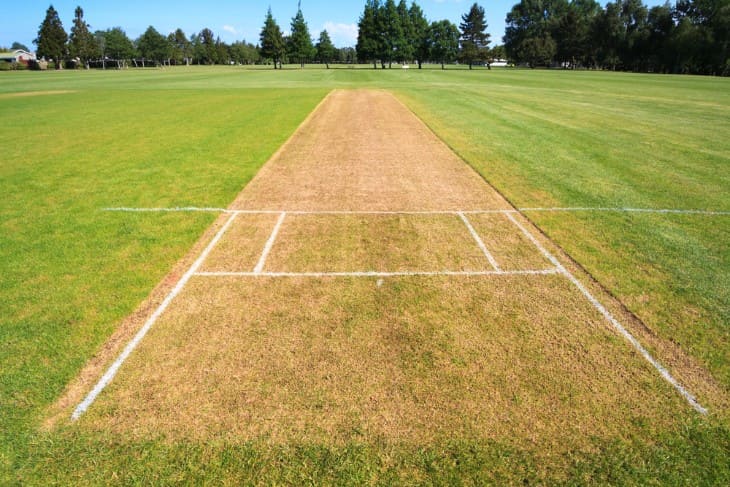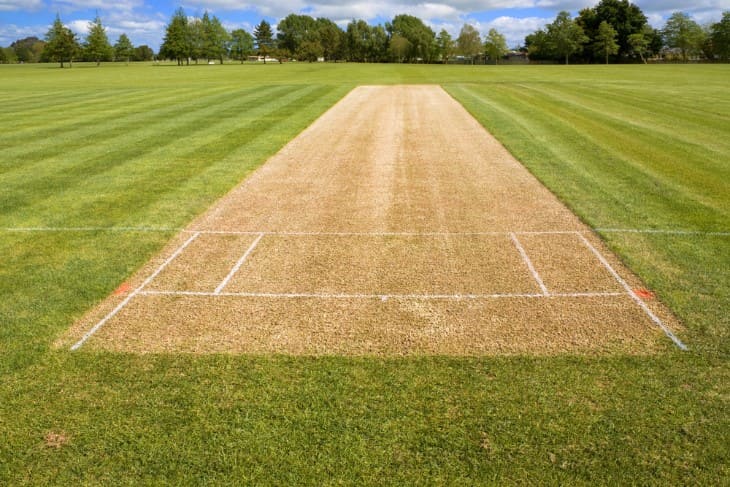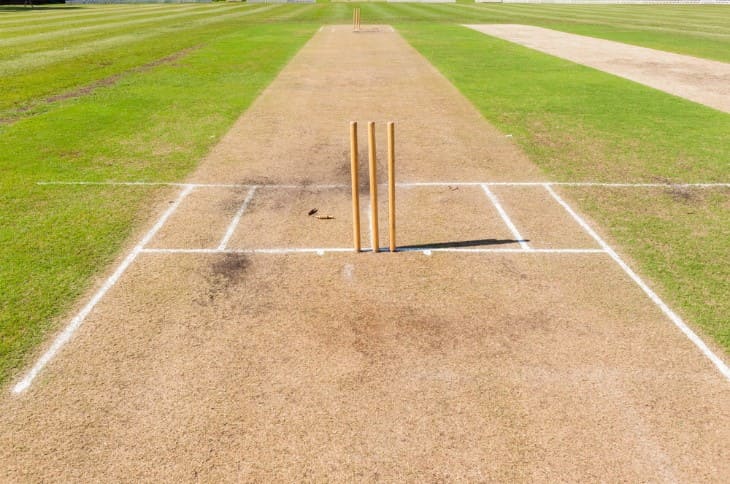Cricket faces significant challenges when rain enters the picture, leading to the common question: "Why can't you play cricket in the rain?" This query points to the practical difficulties rain introduces to the game. Rain makes the playing field slippery, affecting fielders' movements and creating hurdles like misfields and dropped catches. Moreover, the pitch can get damp, giving bowlers an advantage with more seam movement. The impact is not just on the game dynamics but also on player safety, leading to pauses or even abandoning matches to prevent injuries. In this context, we'll explore how rain disrupts the playing conditions in cricket and the measures taken to navigate these challenges.
Wet Outfield
Why can’t you play cricket in the rain? Well, when rain falls, this area can become saturated, creating a slippery and demanding surface. The wet conditions pose challenges for fielders, impeding their ability to move swiftly, slide, or dive to halt the cricket ball. Consequently, misfields become more frequent, and the likelihood of dropped catches increases, impacting the overall performance of the fielding team. Moreover, the wet outfield introduces an element of unpredictability, influencing the dynamics of the game and requiring teams to adapt their strategies accordingly.
Player safety is a paramount concern when dealing with a wet outfield. The slippery surface increases the risk of injuries as players attempt rapid movements, sudden stops, and dives. Umpires closely monitor the conditions, and in cases where safety is compromised, they may temporarily suspend or even abandon play. The well-being of the players takes precedence, highlighting the importance of ensuring a safe playing environment.
Teams facing a wet outfield must navigate strategic adjustments to cope with the challenges it presents. Adaptation becomes crucial as players need to modify their approach to fielding and batting to suit the conditions. Bowlers, in particular, may need to reconsider their grip on the ball, and fielding sides must be prepared for a higher likelihood of misfields and potential changes in the overall momentum of the game.
Key Points
- Slippery Surface: Rain creates a slippery playing field, hindering players' agility and fielding capabilities.
- Safety Concerns: The risk of injuries increases on a wet outfield, prompting umpires to prioritize player well-being.
- Strategic Adaptation: Teams must adjust their strategies to cope with the challenges posed by a wet outfield, influencing both batting and fielding approaches.
Damp Pitch
In cricket, a damp pitch refers to the playing surface in the centre of the field, where the bowler delivers the ball to the batsman. When rain occurs, this crucial area can absorb water, making the pitch damp. The impact of a damp pitch is significant as it directly influences the behaviour of the ball during a match. A damp pitch tends to provide more assistance to bowlers, particularly fast bowlers, as the moisture allows the ball to move off the seam and swing more than usual. This added movement makes it challenging for batsmen to predict the trajectory of the ball, increasing the likelihood of dismissals.
Batsmen facing a damp pitch encounter a more formidable challenge, as the unpredictable movement of the ball can make shot selection and timing more demanding. The dampness affects the bounce and pace of the ball, making it trickier for batsmen to play their shots confidently. Additionally, spin bowlers may find it challenging to grip the ball effectively on a damp pitch, reducing the amount of turn they can achieve. This dynamic between the damp pitch and the ball's behaviour creates a fascinating and sometimes tense battle between batsmen and bowlers, where adaptability and skill become crucial for success.
The impact of a damp pitch on gameplay is not limited to the batting side; bowlers also need to adjust their strategies. Fast bowlers, in particular, may exploit the conditions by focusing on seam movement and swing, aiming to capitalize on the assistance offered by the damp surface. Spin bowlers, on the other hand, might need to rely more on variations in pace and trajectory, as the moisture can hinder the effectiveness of traditional spin deliveries.
Key Points
- Bowlers' Advantage: A damp pitch provides more assistance to bowlers, especially fast bowlers, allowing the ball to move off the seam and swing.
- Challenges for Batsmen: Batsmen face difficulties in shot selection and timing due to the unpredictable movement of the ball on a damp pitch.
- Bowlers' Adjustments: Both fast and spin bowlers need to adapt their strategies to make the most of the conditions, with a focus on seam movement and variations in pace.

Delay in Play
When rain interrupts a match, the playing surface, including the pitch and outfield, becomes wet and unsafe for players. In response, groundsmen cover the pitch and the surrounding area with protective covers to prevent excessive moisture absorption. Despite these efforts, the delay allows time for the ground to dry, ensuring a safer and more conducive playing environment.
The duration of the delay depends on the intensity and duration of the rain. Short, light showers may result in a brief pause, with players waiting in the pavilion until conditions improve. However, prolonged or heavy rainfall can lead to more extended delays, impacting the overall schedule of the match. During these delays, players often engage in activities to stay focused and maintain their readiness for when play resumes. Umpires and match officials play a crucial role in assessing the conditions and determining when it is safe to resume the game.
Once the rain subsides and the ground is deemed playable, the covers are removed, and the pitch undergoes inspection to ensure it is suitable for play. If the outfield and pitch remain wet, additional measures such as using equipment to absorb excess water or rolling the pitch may be employed to expedite the drying process. Ultimately, the decision to resume play rests with the umpires, who prioritize the safety of the players and the integrity of the game.
Key Points
- Safety Concern: Rain causes delays as the wet playing surface poses safety risks to players.
- Variable Duration: Delay duration depends on the intensity and duration of the rain, with longer delays for heavy rainfall.
- Umpires' Role: Umpires and officials assess the conditions, decide when it's safe to resume play, and ensure the integrity of the game.
Reduced Overs
Here is another answer to the question why can’t you play cricket in the rain – Reduced Overs! When rain interrupts play, it reduces the available time for both teams to complete their innings. In such cases, the total number of overs in the match is adjusted to ensure fairness, allowing each team a reasonable opportunity to bat and bowl. The method used to calculate the revised target is known as the Duckworth-Lewis method, which considers the number of overs lost and the current state of the game to set a new target for the team batting second.
Reduced overs can significantly alter the dynamics of a cricket match. Teams may need to modify their strategies, and batsmen must adjust their approach to score runs more efficiently within the limited overs. Similarly, bowlers may need to be more strategic in their plans, focusing on quick wickets to limit the opposition's scoring potential. The pressure on both teams increases, as the margin for error decreases in the shortened format, making every run and wicket crucial.
The decision to reduce overs is typically made by the match officials, considering the severity of the weather disruption and the time available to complete the game. This adjustment ensures that despite the interruptions, the contest remains competitive and fair to both teams. While reduced overs may be an outcome of weather-related challenges, they also showcase the adaptability and resilience of teams in navigating unexpected situations during a cricket match.
Key Points
- Rain-Induced Adjustment: Reduced overs occur when rain interrupts play in limited-overs cricket matches.
- Duckworth-Lewis Method: The Duckworth-Lewis method is used to calculate a revised target for the team batting second based on the overs lost and the state of the game.
- Strategic Changes: Reduced overs require teams to modify their strategies, with batsmen and bowlers adjusting their approach to the shorter format.
Duckworth-Lewis Method
The Duckworth-Lewis Method is a mathematical formula used in cricket to adjust targets in rain-affected limited-overs matches. It was introduced to address the challenges of determining a fair target for the team batting second when rain interruptions occur. The method takes into account the number of overs lost and the current state of the game to recalculate the target score for the team batting second, ensuring that they have a reasonable chance to chase down the adjusted total. The aim is to make the game equitable, considering the impact of weather interruptions on the overall balance between bat and ball.
The Duckworth-Lewis Method involves a complex algorithm that considers various factors, including the number of overs bowled, the number of wickets lost, and the scoring rate at the time of the rain interruption. The system uses historical data to establish average scoring patterns and player performance, contributing to a fair and standardized method for determining revised targets. This mathematical approach aims to provide a level playing field, acknowledging that rain can significantly impact the course of a cricket match.
Cricket teams and fans often scrutinize the Duckworth-Lewis calculations, as they play a crucial role in deciding the outcome of rain-affected matches. While the method may seem intricate, its purpose is straightforward: to ensure fairness and competitiveness in limited-overs cricket, allowing teams to have a fair chance of success despite weather-related disruptions.
Key Points
- Target Adjustment: The Duckworth-Lewis Method is used to adjust the target score in rain-affected limited-overs cricket matches.
- Factors Considered: The formula takes into account the number of overs bowled, wickets lost, and the scoring rate at the time of the rain interruption.
- Fairness and Competitiveness: The method aims to provide a fair and competitive scenario for both teams by recalculating the target based on the impact of rain on the game.
Player Safety
You can’t always play cricket in the rain because player safety is a top priority. Various factors contribute to ensuring a safe playing environment, and match officials, including umpires and ground staff, play a crucial role in monitoring and addressing potential safety concerns. One significant aspect of player safety is the condition of the playing surface, particularly when adverse weather, such as rain, affects the outfield and pitch. Wet conditions can make the surface slippery, increasing the risk of players slipping or injuring themselves during rapid movements, dives, or sudden stops. In response to such conditions, umpires may temporarily suspend play or even abandon the match to avoid compromising the safety of the players.
Additionally, protective equipment is a fundamental aspect of player safety in cricket. Batsmen, in particular, wear helmets to shield themselves from fast deliveries, bouncers, and unexpected bounces. Bowlers also use protective gear, such as helmets and guards, to minimize the risk of injury. Umpires closely monitor the usage and condition of protective equipment to ensure it meets safety standards. Concussion protocols have gained prominence in recent years, with players undergoing assessments if they experience head injuries to determine their fitness to continue playing.
Player safety extends beyond the field, encompassing measures to address physical and mental well-being. Teams often have support staff, including physiotherapists and sports psychologists, to attend to players' health and mental resilience. Training regimens are designed to balance physical fitness and prevent injuries. The cricketing community acknowledges that prioritizing player safety not only preserves the integrity of the game but also contributes to the overall welfare and longevity of athletes in the sport.
Key Points
- Wet Conditions: Umpires monitor and respond to wet conditions that can make the playing surface slippery, posing injury risks.
- Protective Equipment: Batsmen and bowlers use protective gear, such as helmets, to minimize the risk of injuries during play.
- Concussion Protocols: Players undergo assessments for head injuries, and there are protocols in place to ensure their well-being.
- Overall Well-Being: Player safety extends to physical and mental well-being, with support staff and training regimens focused on preserving athletes' health.

Ball Maintenance
Ball maintenance is a crucial aspect of cricket, influencing the performance of both bowlers and batsmen. And, that’s why you can’t always play cricket in the rain. The condition of the cricket ball can significantly impact its movement in the air and off the pitch. Fast bowlers, in particular, aim to maintain the shine on one side of the ball to encourage swing, which is the lateral movement of the ball through the air. Bowlers often use saliva or sweat to shine the ball, and maintaining the shine allows them to generate more swing, making it challenging for batsmen to predict the trajectory of the delivery. Conversely, batsmen prefer a less shiny ball as it reduces the amount of swing and movement, making it slightly easier to play strokes.
During a cricket match, the condition of the ball is carefully monitored by the fielding team, particularly the bowlers. If the ball becomes scuffed, scratched, or loses its shine, it can affect the overall quality of play. In response, players often use towels to dry the ball, removing excess moisture that might accumulate during wet conditions. Umpires also play a role in ball maintenance, ensuring that any substances used to shine the ball comply with the rules and regulations of the game. The strategic manipulation of the ball's condition adds an intriguing element to the contest between bowlers and batsmen, requiring teams to adapt their tactics based on the state of the ball.
Key Points
- Swing Factor: Fast bowlers aim to maintain the shine on one side of the ball to encourage swing, making it challenging for batsmen.
- Player Involvement: Bowlers use saliva or sweat to shine the ball, and both teams monitor and adapt to the ball's condition during a match.
- Umpire Oversight: Umpires ensure that substances used for ball maintenance comply with the rules and regulations of the game.
Spectator Experience
The spectator experience in cricket is a vital component that adds vibrancy and excitement to the game. Cricket matches attract a diverse audience, from passionate fans to families, and the overall experience encompasses several elements. The atmosphere in the stadium, created by cheering crowds, music, and team anthems, contributes to the sense of camaraderie and enthusiasm among spectators. The sight of colourful jerseys, waving flags, and the energy of the crowd all contribute to the unique and engaging atmosphere that characterizes cricket matches, particularly in major tournaments or when rival teams face off.
The viewing experience is also enhanced by the provision of facilities in the stadium. Concessions offering a variety of food and beverages, comfortable seating arrangements, and amenities like big screens for replays contribute to a positive spectator experience. The excitement of witnessing thrilling moments, such as spectacular catches, powerful sixes, and close finishes, adds to the overall enjoyment for fans. Moreover, the interaction between players and spectators, such as players acknowledging the crowd's support or tossing a ball into the stands, fosters a sense of connection and shared excitement.
Key Points
- Atmosphere: The atmosphere in the stadium, created by cheering crowds, music, and team anthems, adds excitement to cricket matches.
- Facilities: Concessions, comfortable seating, and amenities like big screens contribute to a positive spectator experience.
- Thrilling Moments: Spectators enjoy witnessing exciting moments, including spectacular catches, powerful sixes, and close finishes.
- Player Interaction: Interaction between players and spectators, such as players acknowledging the crowd's support, enhances the sense of connection.
Summary
Rain significantly impacts playing conditions in cricket, creating a slippery slope of challenges for both teams. When rain falls, the outfield becomes wet and slippery, affecting fielders' ability to move quickly, resulting in misfields and dropped catches. The pitch can also become damp, providing more assistance to bowlers, especially those who rely on seam movement. Delays in play are common as groundsmen cover the pitch and outfield to protect them from excessive moisture. The Duckworth-Lewis method may come into play in limited-overs formats, adjusting targets if rain interrupts the match. The safety of players is paramount, so the question "Why can't you play cricket in the rain" also underscores the risks associated with slippery conditions, leading to temporary suspensions or even match abandonments to ensure player safety. Overall, rain introduces a series of challenges, requiring adaptability from players and officials to navigate the unpredictable nature of weather in cricket.


